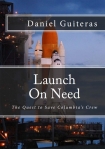Launch on Need, Daniel Guiteras [the giving tree read aloud TXT] 📗

- Author: Daniel Guiteras
Book online «Launch on Need, Daniel Guiteras [the giving tree read aloud TXT] 📗». Author Daniel Guiteras
“Okay, now we have to do this quickly,” Stangley told his cameraman. “If they catch us up here, they will likely ban us entirely.”
“Gee, ya think? But hey I’m not worried,” Al said. “You’d probably talk your way out of that, too.”
When the two reached the observation deck, they found it empty—exactly the way Stangley’s contact said it would be at this early hour.
Al squatted to quickly check his camera’s battery and light levels, then confirmed he was ready to start filming. “You need to do anything before we start?” he asked.
“No, I’m ready, been here countless times before. I think I can do it straight from memory,” Stangley said, quickly taking the microphone in hand and backing up, placing his back against the deck’s railing.
Al hoisted the camera to his shoulder. “Alright then, we go in five, four…”
Stangley reminded himself to control his pacing. Whenever his potent level of excitement was mixed with a subject he knew well—like the NBL—he tended to rush his speech like a teenager in front of his English class.
He spoke to the camera’s red record light with fervor, as if the light was his target audience: living, breathing beings, the most interested pupils he’d ever known, people just like himself who shared his love for NASA’s manned spaceflight program, and man’s arduous quest for knowledge.
“If you were led blindfolded to where I’m standing now, which is the observation deck of NASA’s neutral buoyancy laboratory,” Stangley began, “known simply as the NBL here in Houston, your other senses would swiftly register the mildly humid air tinged with the odor of chlorine, and the high-ceiling echoey acoustics one typically associates with indoor pools. But if the blindfold were removed, you’d gasp in shock as your brain tried to comprehend all that your eyes would see.”
Stangley reached out over the railing, pointing to the boundaries of the huge room, and the camera followed, panning from left to right before zooming down for a closer view of the world’s largest indoor pool.
Below the observation deck, the camera captured a half-dozen staff members swimming laps. They left delicate streamers of froth in the deliciously blue chemically balanced pool water. Along the far end of the deck, team members had begun unloading a bevy of gear from commercial-grade dollies.
“So this is where astronauts come to learn how to perform spacewalks. They practice using specially designed power screwdrivers and wrenches, and practice specific assembly procedures required for the construction of the International Space Station. But as we’ll see later this morning when we join Mission Specialists Garrett and Mullen poolside, astronauts sometimes come to the NBL to learn last-minute rescue procedures for a marooned shuttle crew.”
Stangley moved to the end of the observation deck to allow the camera to capture the long view of the pool.
“Now, the NBL began training astronauts in January 1997. So this is a relatively new facility, replacing the much smaller weightless environment training facility. The NBL pool measures two-hundred-two feet in length, one-hundred-two feet in width, and forty feet in depth. The pool’s designers were able to achieve a depth of forty feet by placing twenty feet of the pool’s depth below ground. To get a sense of how big this pool is—and those of you with swimming pools at home will appreciate this—the NBL pool is so large, it took twenty-eight days to complete the initial filling and six-point-two million gallons of water.
“So why use a pool to learn how to spacewalk, you ask? Can’t the simulations be done with a computer or some other method, you wonder? Well, the answer is that some spacewalking simulations can be accomplished with computer simulation, but no matter how fancy the programming, it lags far behind the authenticity that astronauts experience while performing spacewalk tasks fully suited, breathing space suit air, and working on life-size mock-ups underwater.
“If you look down through the surface of the water, you’ll begin to understand what I mean about authenticity.” The camera zoomed for a tight shot of the water.
“Even though the NBL pool has the volume of ten Olympic-size pools, you don’t see any lane lines painted on the bottom, or floating lane markers stretched along the pool’s length. Instead, NASA engineers constructed lifelike mock-ups, then lowered them carefully to the pool’s bottom using those bright-yellow deck-mounted jib cranes and the two overhead bridge cranes, each capable of lifting ten tons. The engineers created the ultimate astronaut playground,” Stangley said.
The cameraman panned across the water while zooming in close. The mock-ups of a shuttle payload bay and trusses of the International Space Station all glistened beneath the pool’s surface like strange sunken space treasures.
Terry Mullen called ahead to the hoist-stand support team, “Hey, you boys ready to go swimming?” His voice was nearly lost amid the cacophony of voices and clanking metal hardware.
“We’re ready,” a technician fired back without looking at the approaching pair of astronauts. “We’re just waiting for the two clowns who are supposed to wear these space suits. Anyone seen…? Wait, here they are now,” the technician said, looking up at them with a smile.
Mullen and Garrett strode cockily along the edge of the pool’s 202-foot length, their self-esteem obviously unaffected by their appearance, not even with better than 100 reporters strewn about the perimeter of the pool, poised for note-taking.
Two of NASA’s finest, clad in black Teva sandals, adult diapers and long underwear.
“Nice outfits, guys!” a technician teased the astronauts as they arrived at the hoist stand. There was no end to the cracks made about the standard long underwear-and-diaper combo worn by all space-suited astronauts. It seemed no matter what level of fitness an astronaut maintained, no matter how provocative the feminine curves, or how formidable the Romanesque pectorals and biceps, no quantity or quality of physical human gift could overcome the decidedly unfashionable space suit undergarments.
Of course, the components of NASA’s fashion combo, like everything else in the





Comments (0)